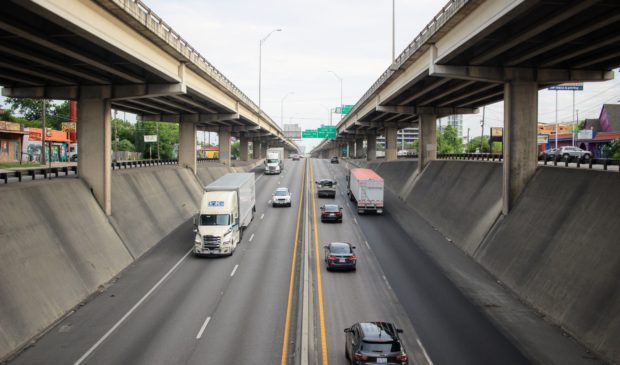TxDOT anticipates ‘meaningful alternatives’ to I-35 expansion in upcoming public input process
Wednesday, July 8, 2020 by
Ryan Thornton Despite the sharp drop in local traffic, renewed interest in teleworking policies, and major upsets to transportation revenue streams, the Texas Department of Transportation has no intention of rethinking the need for a $6.6 billion expansion of Interstate 35 through Central Austin between U.S Highway 290 East and Ben White Boulevard.
“When we plan projects like these, we’re planning many years out, so we’re planning for 2040, 2045,” Susan Fraser, project manager for the corridor, told the Pedestrian Advisory Council on Monday. “So even with telework, and even with changes in driving and those attitudes, we still are going to need this additional capacity.”
The agency is kicking off the public input process for the central leg of the Capital Express project this fall, where the TxDOT Austin District will be gathering feedback to inform a project design proposal. Fraser said the state’s only current design feature is likely depressed lanes through the city center, but other alternatives will also be considered.
Even with traffic levels returning to normal, advisory council members cited realities such as traffic deaths, air pollution, induced demand and a cultural shift away from driving as reasons to consider alternatives to the project’s most basic assumptions.
Jay Crossley said asking for meaningful input should necessarily involve “entertaining meaningful alternatives” to the current “business-as-usual” proposal, including a no-build scenario, a design better optimized for all modes of transportation, and the option to reroute the interstate via U.S. Highway 183 or State Highway 130 and allow a “more efficient” street grid in the city.
At a meeting organized by Austin Tech Alliance on Tuesday, Heyden Walker of Reconnect Austin said the option to reroute the interstate has been recommended by multiple stakeholder groups yet is “consistently ignored” by the state.
One of the primary benefits of the Capital Express project would be to create “managed lanes,” possibly tolled lanes that could free transit buses and other vehicles from general traffic. Federal law prohibits converting existing interstate traffic lanes into tolled lanes, but Walker said rerouting the interstate along State Highway 130 would solve that technical issue and allow for a cheap and easy tolled-lane conversion on what is currently I-35.
Although the state has not indicated interest in such alternative scenarios, Fraser said those kinds of solutions represent the kind of feedback the agency is looking to hear in the fall.
In August, the Texas Transportation Commission will vote to include the remaining $307 million funding gap for the Capital Express central project in its 2021 Unified Transportation Program. The decision does not guarantee funds will be available but will allow for the project design to be further developed.
While the current proposal would include improved sidewalks and bike paths along the corridor, Walker said similar improvements in recent years have failed to account for the need to physically separate high-speed traffic from people walking, bicycling and rolling. Citing a relatively new shared-use path directly adjacent to the I-35 service road at Oltorf Street, Walker said the improvement appears to place people in a “clear zone” and represents the state’s low priority on protecting human life.
“A clear zone is an area for a car that has gone out of control to recover and TxDOT has a very long history of putting facilities for human beings – sidewalks and bicycle paths – in clear zones,” Walker said. “Even if this is not a designed clear zone, clearly a truck traveling at high speed on this 12-foot lane, a 12-inch curb is not going to do much to stop the truck.”
Chair Adam Greenfield said the board may soon consider forming an I-35 corridor subcommittee to address the numerous flaws with the state’s proposal ahead of the upcoming public process.
“It’s just not clear to me why this is being proposed on a highway that is already killing a lot of people,” Greenfield said. “The wider you make it, the faster people are going to drive and the more people are going to die. It just seems to me like this is really doubling down on an approach that hasn’t worked for 80 years now.”
The Austin Monitor’s work is made possible by donations from the community. Though our reporting covers donors from time to time, we are careful to keep business and editorial efforts separate while maintaining transparency. A complete list of donors is available here, and our code of ethics is explained here.
You're a community leader
And we’re honored you look to us for serious, in-depth news. You know a strong community needs local and dedicated watchdog reporting. We’re here for you and that won’t change. Now will you take the powerful next step and support our nonprofit news organization?






